How to create a digital product
Creating and selling digital products is a great way to earn passive income without the need for physical inventory or shipping.
With low startup costs and high profit margins, your ideas can have an impact on people worldwide.
This extensive guide gives you a clear plan to create, launch, and scale your digital product business.
Whether you’re a creative professional, industry expert, or passionate hobbyist, you’ll learn how to package your knowledge into products that your audience will love.
Keep reading to discover the exact steps.
What are digital products?
Digital products are items you can sell online that customers can instantly download, such as ebooks, courses, templates, and software.
1. Brainstorm product ideas
The first step in creating your own digital products is to generate great ideas. The best digital products solve real problems, so you should find the perfect match between your skills and what your audience wants.
Here are some effective ways to come up with new product ideas:
Look at your experiences
Think of your personal knowledge and expertise as a gold mine of ideas.
- Your skills. What problems have you solved? What shortcuts have you found? What processes have you improved? Chances are, someone needs these insights as well.
- Your journey. What big goals have you achieved? What challenges have you overcome? Your path to success might be what others want to learn.
- Teaching others. What do people often ask you to explain? If you keep helping others with the same thing, that’s a product idea you can explore.
Listen to your audience
Your potential customers might already be telling you what they want.
- Online groups. Check Facebook groups, Reddit, and Discord to see common problems people keep asking about.
- Explore comments. Read comments on your social media posts and competitors’ content. Look for phrases like “I wish someone would…” or “Does anyone know how to…”
- Track questions. Go through your DMs, emails, and any consultation calls you might have had to spot common themes and identify what questions people often ask.
Find what’s missing
Sometimes great product ideas come from identifying what’s missing.
- Simpler tools. Look for examples where people use multiple tools to solve one problem. Could you create an all-in-one solution?
- Update processes. Do you see outdated processes that need a fresh approach? For example, replace manually entering receipts into spreadsheets with a system that uses photos and AI.
- New price point. Are there missing price tiers in certain markets? For example, between free YouTube tutorials and $2,000 coaching programs, there could be room for a $200 course.
Check your content
If you’ve already posted content on a blog or social media, this can provide you with helpful ideas.
- High performers. Which blog posts, videos, or social posts get the most engagement? These topics clearly resonate with your audience.
- Frequently asked questions. Go through comments on your content to spot themes and common pain points people regularly bring up.
- Content expansion. What topics in your content can be enhanced with videos, templates, or other formats? And where can you expand on content to create a course?
Study others
Learn from what others are doing well and where you see room for improvement.
- Create improvements. Identify successful products in an industry and see how you could offer something better or different.
- Check other fields. Look at products in other niches and see if you can adapt those ideas to a different market.
- Try new formats. Are there existing products that you can adapt into different formats? For example, can a set of templates be turned into a course? Or an ebook into an app?
Think ahead
Sometimes great product ideas come from identifying what’s missing.
- Industry trends. What changes are coming to your industry? What tools will people need to use going forward?
- Technology impact. How can emerging technologies like AI solve existing problems in new ways? You can create training courses that teach people how to use these tools.
- Skill growth. What new skills will your audience need in the next 1-2 years? Be there first with the solution or teach them these skills.
Brainstorming exercise
Go through these brainstorming methods above and choose a few that apply to your situation.
Spend 30 minutes on each, create a spreadsheet, and list every possible product idea that comes to mind, even if it feels like a stretch.
Rate each idea from 1-5 (with 5 being the best) based on a combination of your skills, whether people want it, and the effort required to create the product.
Pick your top 3 ideas to validate whether they’re worth pursuing in the next step.
Remember, your goal is to find the sweet spot between your strengths and what your audience truly wants.
2. Conduct market research
Now that you have a few product ideas to consider, you need to determine whether they are actually good ideas.
Market research is an important process that helps you catch potential problems early, improve your idea based on audience feedback, and make sure there’s real demand before investing too much.
The last thing you want is to pour months into creating products that nobody wants.
Let’s explore how to test your product ideas.
- Look at search trends. Use Google Trends to see how many people are searching for products like yours. This helps you spot if interest is growing, declining, or seasonal. Ideally, you want the trendline to be going up or at least remaining steady.
- Check out your competition. Look at other businesses selling similar products and take note of what they charge, how they present their products, and what kind of reviews they have. This can show you what works and what gaps you can fill.
- Create a customer profile. Write down your ideal customer’s age, interests, and problems. This will help you know exactly where and how to market your product to them.
- Listen to online conversations. Pay attention to what people say on social media and forums about similar products. This will show you what features people want and what problems they’re trying to solve.
- Talk to potential customers. Reach out to people engaged in online discussions about similar products, and chat with them about their needs and what they think of your idea.
- Actively seek feedback. Start sharing content about your product idea on social media platforms where your target customers hang out. Engage with followers and use their feedback to validate your product idea.
3. Plan your product
Now that you have an idea of the type of digital product you want to create, let’s explore how to structure one that your audience will love.
Start with the purpose
Think about what your customers want to achieve. Are they looking to learn a new skill, solve a specific problem, or start a business from home?
Your product should guide them from where they are to where they want to be.
Outline key steps
Map out your customer’s learning path from beginning to end, with key steps that build on each other.
For example, if you’re teaching Instagram marketing, the steps might look like this:
- Understand basic features and tools
- Learn about content types
- Set up an engaging profile
- Research your audience
- Set up a simple content calendar
- Develop your unique voice
- Engage meaningfully with your audience
- Work with complementary brands
For software products, think about what steps users need to take and how features should flow together naturally.
For example, if you create a social media scheduling tool, the user journey might look like this:
- Quick account creation with email or social login
- Simple social media account connection
- Scheduling your first post
- Drag-and-drop calendar for easy schedule adjustments
- Analytics dashboard to track performance
- Recommendations based on trends and stats
Provide different resources
Everyone learns differently, so give your customers different resources to keep it engaging.
For example, if your Instagram marketing course includes step-by-step instructions, combine each step with screenshots that show exactly what to do. Better yet, record your screen as you walk through the process, talking customers through each click.
That way, students can read, watch, and hear exactly what to do.
Lizzie Studio does this well. They provide sewing patterns as downloadable PDFs and include video instructions to clarify each step.
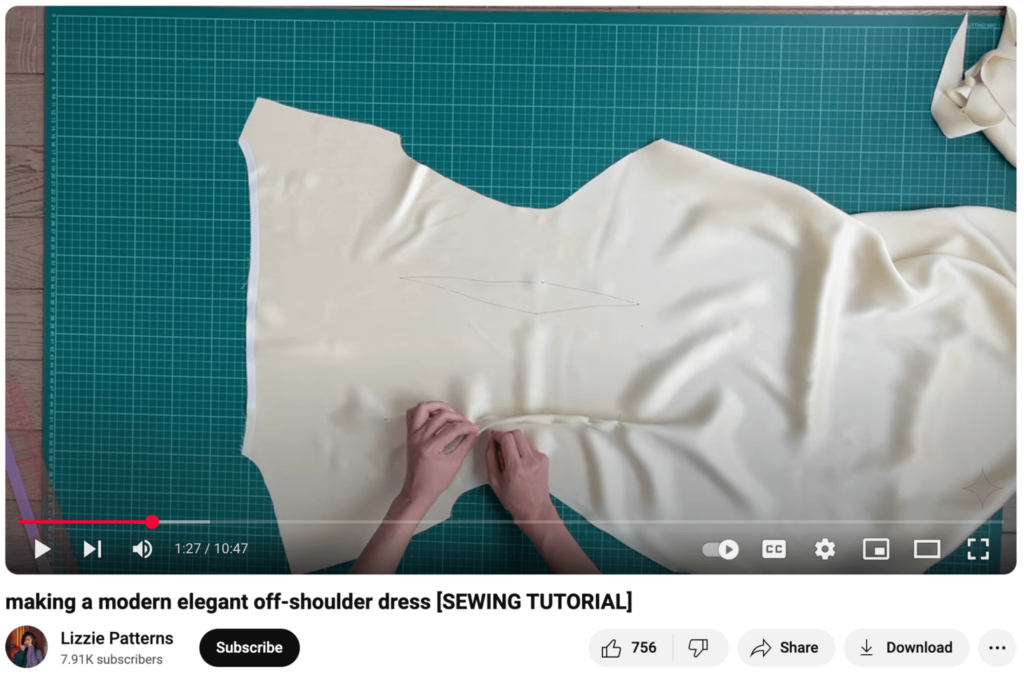
Here are different resources to try:
Written content:
- Step-by-step action plans
- Simple checklists
- Case studies with real examples
- Worksheets
Visual content:
- Screenshots that explain the steps
- Before/after photos
- Charts and graphs
- Tutorial videos
Audio content:
- Expert interviews
- Q&A recordings
- Customer success stories
- Guided brainstorming sessions
Digital tools:
- Calculators
- Spreadsheets with built-in formulas
- Design templates
- Apps with interactive lessons
Make it easy to digest
For courses and ebooks, create short lessons where customers learn one useful skill at a time. This way, each lesson feels like a quick win that builds confidence and momentum.
For software and templates, each feature should have one clear purpose, making it easy for users to go from one step to the next.
The last thing you want is for customers to feel confused and overwhelmed while going through your course or using your software.
4. Create your digital product
Great digital products should be helpful and easy to use, and this is what you should aim for when designing them.
Let’s explore how to create digital products your customers will love.
Create ebooks
Starting an ebook involves organizing your content so that it flows naturally for your readers. Consider creating clear chapters, writing easy-to-read text, and having an engaging design.
Some great tools for creating professional ebooks include Canva, Adobe, and Designrr. These tools handle the design aspects so you can focus on writing great content.
Look at Mama World for inspiration with their collection of ebooks on baby-led weaning. They keep the content simple and organized for busy mothers.
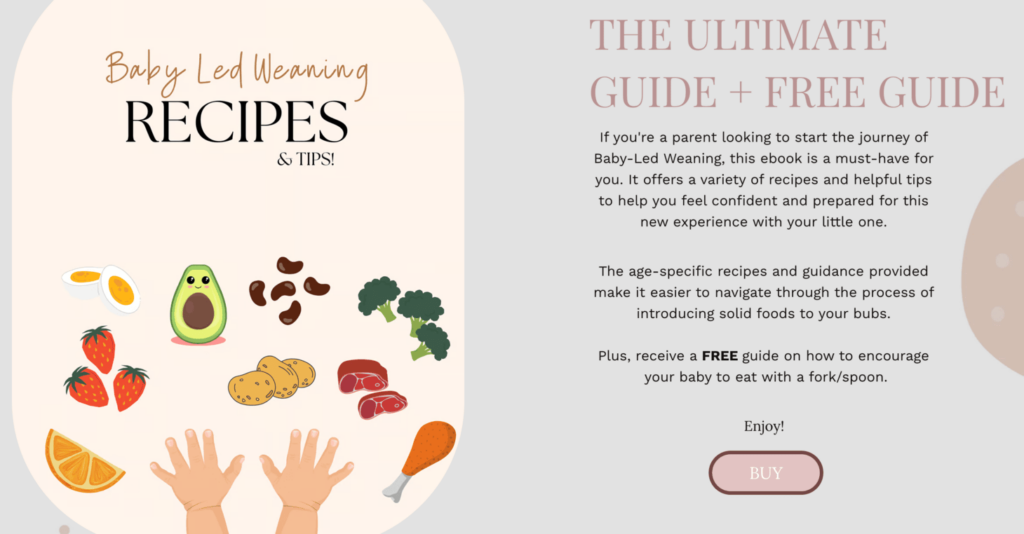
Create software
If you want to create a software product, the key is to figure out exactly what problem you’re solving for customers. Then map out the main features by thinking through how people will use your tool.
The good news is you don’t need any coding skills to create an amazing product. There are great online tools that let you create helpful products easily. All you do is describe the type of software you want to build and let AI handle the rest.
Develop online courses
Creating an online course that students will actually complete starts with a smart content structure. Break down your knowledge into bite-sized pieces that are easy to understand and follow.
Tools like Teachable make it easy to create and sell your course, while Kajabi is another great option that provides everything from course creation to marketing tools all in one place.
Check out what The Pickleball Experience does with their training guide, which includes over 40 drills to address a player’s weaknesses and build on their strengths.
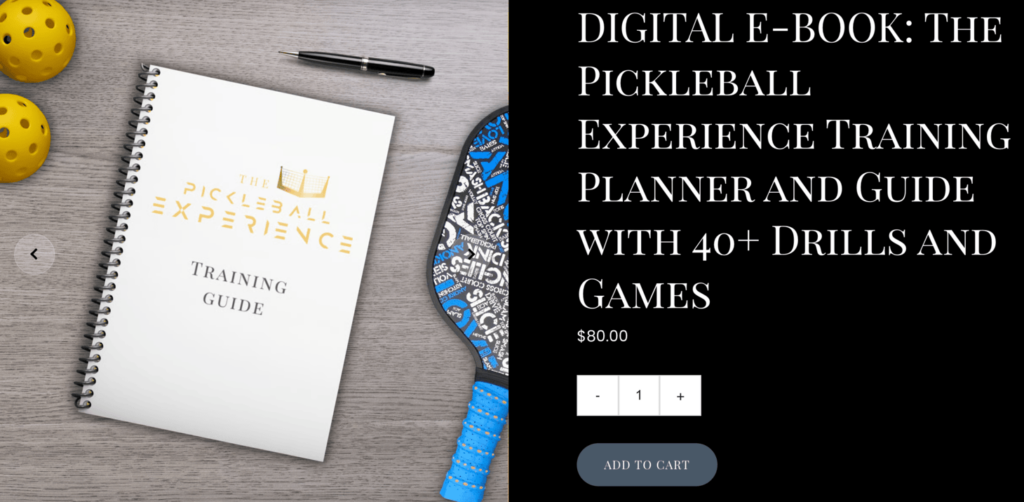
Create templates
Templates are ready-to-use tools like printable journal pages, craft patterns, or social media layouts. Great templates should have enough detail to help people succeed while staying flexible enough to let them add their own personal touch.
Canva is great for creating all kinds of templates, while Adobe Illustrator and Inkscape work great for craft patterns.
Lizzie Studio’s collection of sewing patterns, which includes designs for dresses, vests, and skirts, provides great examples of digital templates.
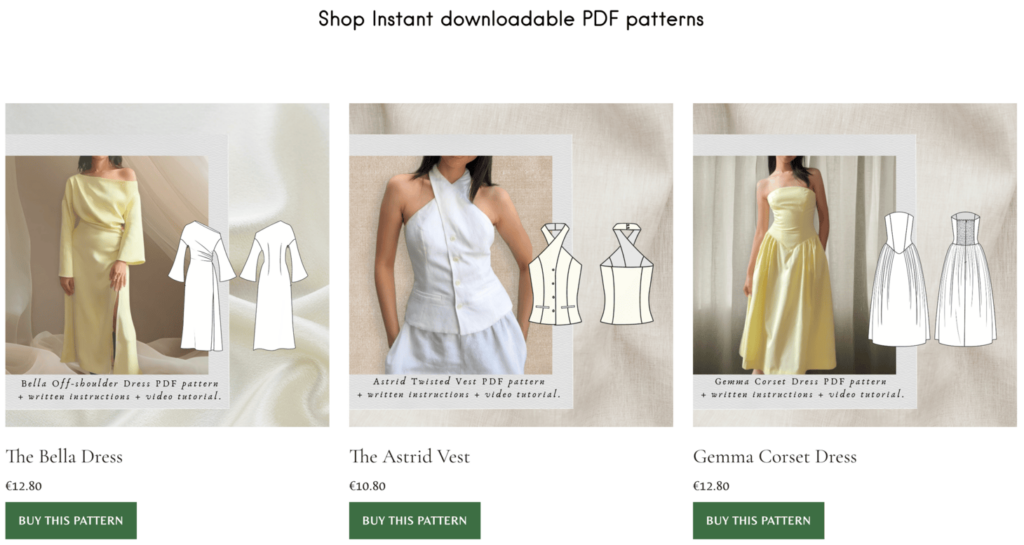
5. Set the stage for sales
Once you’ve created your product, it’s time to let the world know. Let’s explore how to showcase and sell digital products through your own website.
- Start with Hostinger Website Builder. With the help of AI, you can make an online store in minutes without any tech skills.
- Make your products look great.. Write effective product descriptions that show how your product helps people. You can use the AI Writer tool in our website builder to make sure they’re done right. Don’t forget to add high-quality photos or videos for a bigger impact.
- Set appropriate price points. Look at what similar products cost and set prices that work for you and your customers. Consider offering packages at different prices to give people options.
- Make buying easy. Keep your checkout simple and make sure customers can access their digital products right away. With our AI website builder, simple checkout and instant digital downloads are already built in.
- Help people find your website. Use Google Keyword Planner to discover keywords related to your product that people search for and use them throughout your website.
- Set up customer support. Make it easy for potential customers to get help by creating a clear FAQ section, offering email support, or connecting WhatsApp to make communication easy.
6. Implement marketing strategies for your product
Whether you’re creating a course, app, ebook, or set of templates, you’ll need a solid marketing plan to make sales.
Here are some proven strategies to help you connect with people who will love what you create:
Grow your audience on social media
Getting attention on social media involves focusing your energy where your ideal customers spend their time.
Here’s how to make it work:
- Choose the right platforms. Rather than spreading yourself thin, pick one or two platforms where your target audience is most active. If you’re selling design templates, Instagram or Pinterest might be ideal. Teaching coding? Reddit, X and LinkedIn could work for you.
- Share valuable content. Give followers a peek into your process, share quick tips, and post about your product development journey. This builds anticipation and helps people feel connected to you and your product before it launches.
Gain traction with your website
Your website is where you build trust with your audience, showcase your expertise, and guide visitors to becoming customers. When done right, it works like a 24/7 salesperson for your digital products.
Here’s how to make it effective:
- Share helpful content. Write blog posts, share before and after case studies, or create short tutorial videos that show you understand your audience’s needs. This builds trust and helps people see how your product could help them.
- Create clear steps to purchase. Build on the free helpful content through product demos and pages designed specifically for people to purchase. This will lead people through a clear purchasing funnel that helps you sell more of your products.
Build your email list
Your email newsletter list is one of your most valuable marketing assets. It’s a group of people who are interested in what you’re doing and want to hear from you.
Here’s how you can start collecting emails:
- Create a helpful free resource. Solve an immediate problem for your target audience with a free resource like a checklist, mini-course, or a specific chapter from your ebook. Offer this to visitors for free in exchange for their email.
- Design an effective signup form. Keep things simple by asking only for their name and email, and let them know they will receive immediate access to your free resource. Have a strong call to action and mention clear benefits.
Look at Dr. Pamela Dragos for inspiration. She offers holistic veterinary consultations and builds her email list with a free guide that helps people figure out why their pets are sick. If readers need further assistance for their pets, they can sign up for paid consultations.
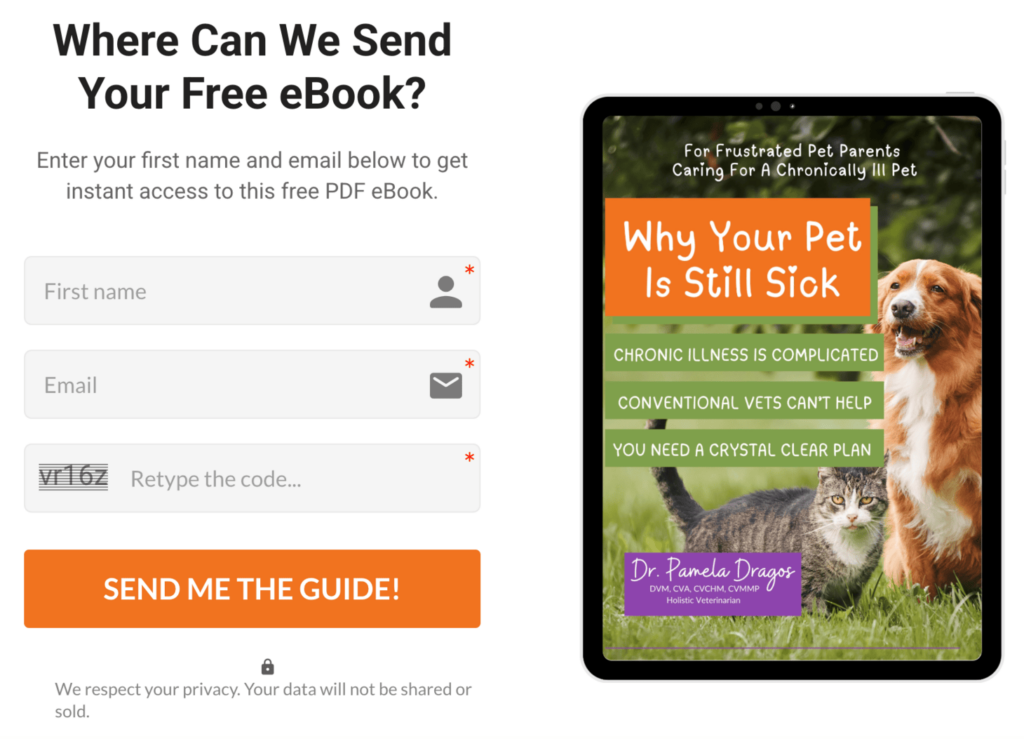
Strengthen relationships through email
Getting someone to join your email list is just the beginning of your relationship. It’s important to also turn their initial interest into a lasting connection.
Here’s what you can do:
- Welcome new subscribers. Create a series of friendly, helpful welcome emails that make a great first impression. Share your best tips, tell your story, and show them how your product could help them even more.
- Ask for feedback and engage. Instead of just broadcasting emails, have conversations with your subscribers. Ask questions, run surveys, and encourage replies. Use this feedback to improve your products and create content they actually want.
7. Launch your digital product
Building on the work you did to gain a following on social media and grow your email list, it’s time to turn that audience into excited customers.
Here’s how to plan your launch for success:
- Build anticipation. Give people a preview of your product. Do a live demo, show specific features, or give away a free sample. Start talking about when your product will launch and any special deals you’re offering.
- Launch day. Email everyone on your list, post on social media, and kick off the launch with a special bonus for the first 20 buyers. For example, you can offer an exclusive one-on-one consulting call or complementary resources.
- Share success stories. In the days after launch, show how your first customers are already using and loving your product. Share their quick wins and positive changes. This helps others see the real value of what you’re offering.
- Create urgency. Remind people when special prices or bonuses are ending, and be specific about what they’ll miss if they wait too long.
- Final push. Share your best customer stories and final bonus offers. Be clear about any price increases coming after launch, and consider hosting a final Q&A session a few days after launch day to answer last-minute questions.
8. Gather feedback and iterate
Now that you know how to successfully launch your digital product, let’s explore how to grow your business.
The key is to listen to your customers. Every piece of feedback from your customers tells you what you can improve and what they want to learn from you.
Here’s how you can receive feedback and make improvements:
Set up your feedback system
- Analyze website data. Use tools like Google Analytics to see how people use your website. Which pages are most popular? Are people regularly leaving your site at a specific place? These patterns can tell you a lot about what customers want.
- Use social media. Read through the comments on your posts, run quick polls, and notice what people say about your content and your products. All forms of feedback here can help you grow.
- Run surveys. Ask focused questions to your email list. Find out what people love about your products, what they don’t like, and what they want to see more of.
Make important changes
- Keep feedback organized. Group similar feedback together to spot patterns. Look at your feedback every month or quarter to plan updates.
- Choose what to fix first. Focus on the issues that affect the main product or that many customers mention repeatedly.
- Test new ideas. Try changes with a small group first before rolling them out to everyone. This ensures your changes are exactly what customers want.
Ready to create a digital product?
Go back to that exercise on the first step to brainstorm a great digital product idea. Remember, the sweet spot is matching your knowledge with what your customers want and value.
Draw inspiration from the successful products of Lizzie Studio, Mama World, and The Pickleball Experience.
These businesses all share one thing in common – their websites are made with Hostinger Website Builder.
When you’ve found your perfect idea, you can use the same tools to reach your ideal customers.
Our AI website maker makes it easy to start selling. You can set up an effective website, accept payments, and deliver your products, all without any technical skills.
How to create a digital product FAQ
How should I market my digital product online?
Start sharing helpful content on social media that shows how your product can help solve people’s problems. Then, with our AI website builder, create a website where you can post more valuable content and build an email list to connect with potential customers.
How do I get feedback from early users of my digital product?
Give a small group of users early access to your digital product in exchange for their honest feedback and suggestions. Make it easy for them to share their thoughts through surveys, polls, and conversations via email and social media.
What is the typical timeline for developing a digital product?
Most digital products take between two to eight months to develop, depending on how extensive the product is, how much time you have to create it, and whether you need to hire others or do it all yourself.



